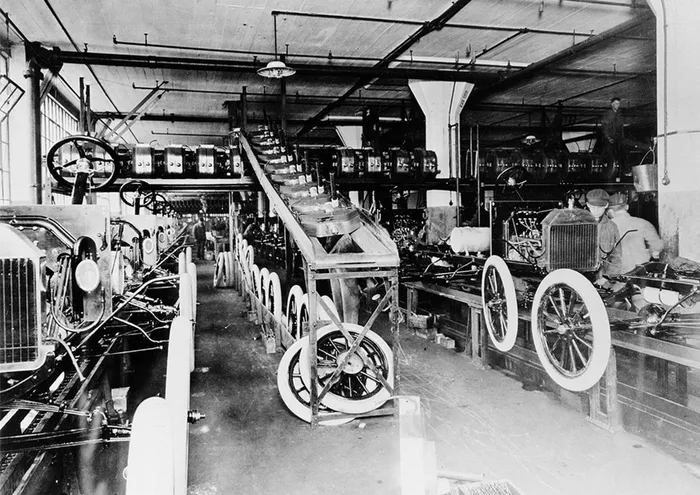The assembly line is 100 years old

Early Model T assembly at Highland Park Plant. Early Model T assembly at Highland Park Plant.
One hundred years ago today, on 8 October 1913, Henry Ford and his team at Highland Park assembly plant launched their greatest contribution to manufacturing - the first moving assembly line.
Up till then, workers brought each of the Model T's 3000 components to a work-space where a single car was completely assembled before another took its place - which took about 12 hours per car.
But now, on the new assembly line, the whole process was broken down into 84 distinct steps, carried out by groups of workers as a rope pulled the car's chassis down the line - and a new Model T rolled off the end of the line about every 90 minutes!
MAKING CARS AFFORDABLE
By reducing the money, time and manpower needed to build cars as he refined the assembly line over the years, Ford was able to drop the price of the Model T from $850 to less than $300. For the first time, ordinary working people could afford what up to then had been a hand-built, expensive luxury carriage.
By 1927 the Highland Park factory was churning them out at a rate of one every 24 seconds and Ford had sold more than 15 million worldwide - at one time it was estimated that one out of every two cars on the road was a Model T!
Incidentally, specialist manufacturers can still supply virtually any part for a Model T off the shelf, which accounts for the large number of ‘Tin Lizzies’, many almost 100 years old, that are still running.
SHAPING THE FUTURE
A century ago, the assembly line was the state of the art; today, Ford engineers are developing an innovative flexible technology to form sheet-metal parts for low-volume production.
It's called FreeForm Fabrication Technology, or F3T, and it will reduce the delivery time for prototype stamped components from between two and six months to three working days.
They're also stretching the capabilities of 3D printing, which creates representations of production components, layer by layer, which can be assembled into testable prototypes.
It's even possible to create several different versions of the same part - by simply re-writing the specification - without spending a cent on tooling, and deliver the prototypes for testing in days rather than months.
ROBOT INSPECTORS
Robots are, above all else, consistent, so the company's new dirt detection system uses robotic cameras to create a digital represention of each car during final assembly, and analyse the paint and surface finishes in comparison with a perfect virtual model - which has not only improved the fit and finish of the cars in Ford showrooms but also gives the inspectors more time to focus on assembly issues that actually require thinking.
Ford's computer geeks have even created a 'virtual factory' (think of it as a gynormous video game) where they can simulate the whole production process, including the way assembly-line workers have to reach and stretch when installing components.
Since this process was introduced in 2001, they say, the number of 'human engineering' problems, where workers have to twist themselves like pretzels to fit certain components, has been reduced by nearly 20 percent.
Related Topics: